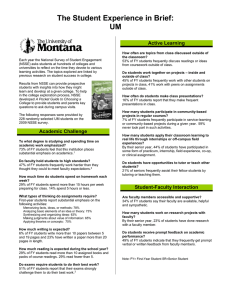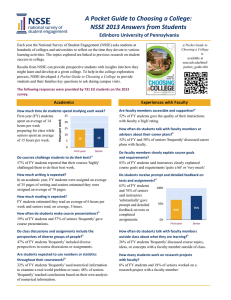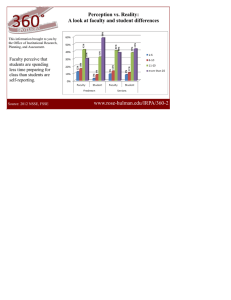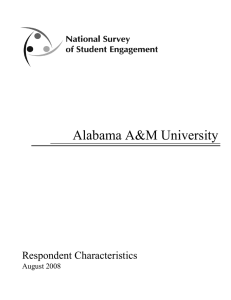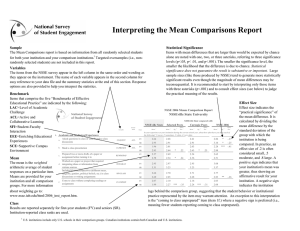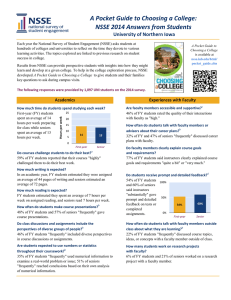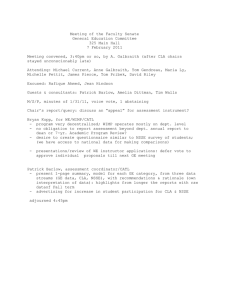A Pocket Guide to Choosing a College: Using the Report
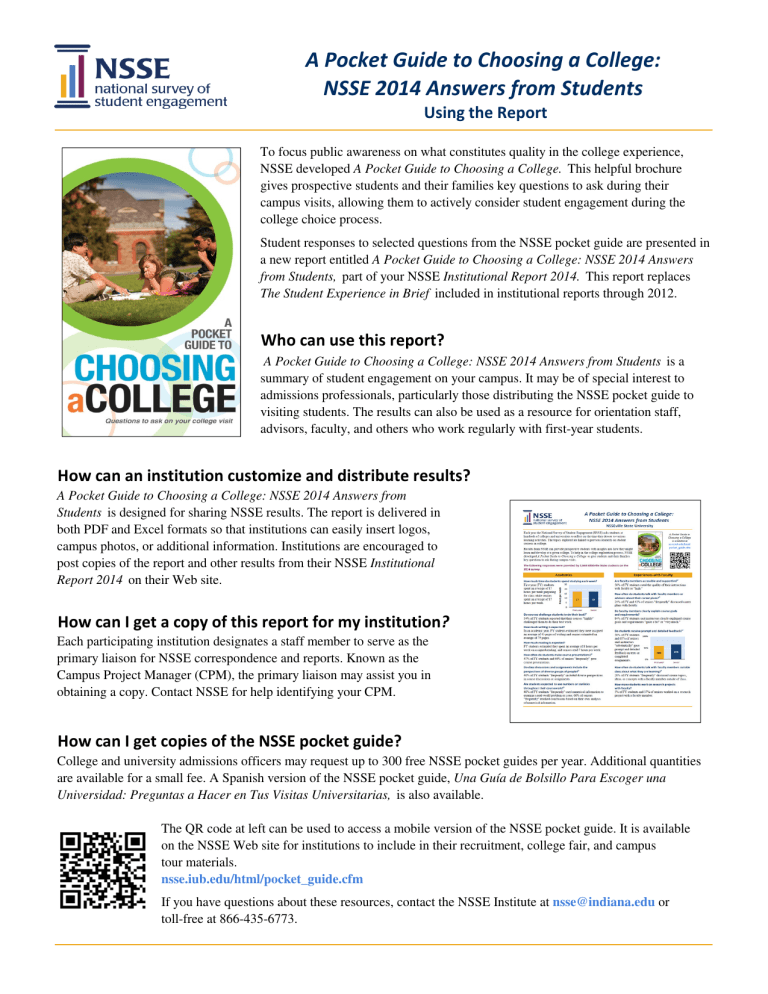
A Pocket Guide to Choosing a College:
NSSE 2014 Answers from Students
Using the Report
To focus public awareness on what constitutes quality in the college experience,
NSSE developed A Pocket Guide to Choosing a College.
This helpful brochure gives prospective students and their families key questions to ask during their campus visits, allowing them to actively consider student engagement during the college choice process.
Student responses to selected questions from the NSSE pocket guide are presented in a new report entitled A Pocket Guide to Choosing a College: NSSE 2014 Answers from Students, part of your NSSE Institutional Report 2014. This report replaces
The Student Experience in Brief included in institutional reports through 2012.
Who can use this report?
A Pocket Guide to Choosing a College: NSSE 2014 Answers from Students is a summary of student engagement on your campus. It may be of special interest to admissions professionals, particularly those distributing the NSSE pocket guide to visiting students. The results can also be used as a resource for orientation staff, advisors, faculty, and others who work regularly with first-year students.
How can an institution customize and distribute results?
A Pocket Guide to Choosing a College: NSSE 2014 Answers from
Students is designed for sharing NSSE results. The report is delivered in both PDF and Excel formats so that institutions can easily insert logos, campus photos, or additional information. Institutions are encouraged to post copies of the report and other results from their NSSE Institutional
Report 2014 on their Web site.
How can I get a copy of this report for my institution
?
Each participating institution designates a staff member to serve as the primary liaison for NSSE correspondence and reports. Known as the
Campus Project Manager (CPM), the primary liaison may assist you in obtaining a copy. Contact NSSE for help identifying your CPM.
How can I get copies of the NSSE pocket guide?
College and university admissions officers may request up to 300 free NSSE pocket guides per year. Additional quantities are available for a small fee. A Spanish version of the NSSE pocket guide, Una Guía de Bolsillo Para Escoger una
Universidad: Preguntas a Hacer en Tus Visitas Universitarias, is also available.
The QR code at left can be used to access a mobile version of the NSSE pocket guide. It is available on the NSSE Web site for institutions to include in their recruitment, college fair, and campus tour materials.
nsse.iub.edu/html/pocket_guide.cfm
If you have questions about these resources, contact the NSSE Institute at nsse@indiana.edu
or toll-free at 866-435-6773.
A Pocket Guide to Choosing a College:
NSSE 2014 Answers from Students
University of Wisconsin-Stevens Point
Each year the National Survey of Student Engagement (NSSE) asks students at hundreds of colleges and universities to reflect on the time they devote to various learning activities. The topics explored are linked to previous research on student success in college.
Results from NSSE can provide prospective students with insights into how they might learn and develop at a given college. To help in the college exploration process, NSSE developed A Pocket Guide to Choosing a College to give students and their families key questions to ask during campus visits.
The following responses were provided by 1,654 UW-Stevens Point students on the
2014 survey.
Academics
How much time do students spend studying each week?
First-year (FY) students spent an average of 14 hours per week preparing for class while seniors spent an average of 14 hours per week.
25
20
15
10
5
14 14
0
First-year Senior
Do courses challenge students to do their best?
a
52% of FY students reported that their courses "highly" challenged them to do their best work.
How much writing is expected?
In an academic year, FY students estimated they were assigned an average of 32 pages of writing and seniors estimated an average of 61 pages.
How much reading is expected?
FY students estimated they spent an average of 7 hours per week on assigned reading, and seniors read 7 hours per week.
How often do students make course presentations?
b
38% of FY students and 67% of seniors "frequently" gave course presentations.
Do class discussions and assignments include the perspectives of diverse groups of people?
b
47% of FY students "frequently" included diverse perspectives in course discussions or assignments.
Are students expected to use numbers or statistics throughout their coursework?
b
34% of FY students "frequently" used numerical information to examine a real-world problem or issue; 56% of seniors
"frequently" reached conclusions based on their own analysis of numerical information.
A Pocket Guide to
Choosing a College is available at nsse.iub.edu/html/ pocket_guide.cfm
Experiences with Faculty
Are faculty members accessible and supportive?
c
50% of FY students rated the quality of their interactions with faculty as "high."
How often do students talk with faculty members or advisors about their career plans?
b
31% of FY and 50% of seniors "frequently" discussed career plans with faculty.
Do faculty members clearly explain course goals and requirements?
84% of FY students said instructors clearly explained course goals and requirements "quite a bit" or "very much."
Do students receive prompt and detailed feedback?
d
61% of FY students and 68% of seniors said instructors
"substantially" gave prompt and detailed feedback on tests or completed assignments.
100%
50%
0%
61%
68%
First-year Senior
How often do students talk with faculty members outside class about what they are learning?
b
20% of FY students "frequently" discussed course topics, ideas, or concepts with a faculty member outside of class.
How many students work on research projects with faculty?
2% of FY students and 31% of seniors worked on a research project with a faculty member.
Learning with Peers
How often do students work together on class projects and assignments?
b
100%
47% of FY students and 75% of seniors
"frequently" worked with their peers on course projects and assignments.
50%
47%
75%
0%
First-year Senior
Do students help each other learn?
b
65% of seniors "frequently" explained course material to one or more students.
How often do students work together to prepare for exams?
b
44% of FY students "frequently" prepared for exams by discussing or working through course material with other students.
How often do students interact with others who have different viewpoints or who come from different backgrounds?
b
Among FY students, 65% "frequently" had discussions with people with different political views, 68% "frequently" had discussions with people from a different economic background, and 57% "frequently" had discussions with people from a different race or ethnicity.
Campus Environment
Are students encouraged to use learning support services (tutors, writing center)?
d
85% of FY students said the institution "substantially" emphasized the use of learning support services.
How satisfied are students with academic advising?
c
47% of FY students and 55% of seniors gave the quality of their interactions with academic advisors a "high" rating.
How well do students get along with each other?
c
60% of FY students gave the quality of their interactions with their peers a "high" rating.
How satisfied are students with their educational experience?
85% of FY and 91% of seniors rated their entire educational experience at this institution as "excellent" or "good."
Rich Educational Experiences
What types of honors courses, learning communities, and other distinctive programs are offered?
During their first year, 12% of students participated in a learning community. By spring of their senior year, 56% of students had done (or were doing) a culminating senior experience.
How many students study in other countries?
By their senior year, 24% of students had studied abroad.
How many students get practical, real-world experience through internships or field experiences?
By spring of their senior year, 58% of students had participated in some form of internship, co-op, field experience, student teaching, or clinical placement.
How many courses include community-based service-learning projects?
e
100% 59% of FY students and 68% of seniors said "at least some" of their courses included a community-based service-learning project.
50%
0%
59%
First-year
68%
Senior
Notes a.
b.
c.
d.
e.
"Highly" is a 6 or 7 on a seven-point scale where 1 is "Not at all" and 7 is "Very much."
"Frequently" is "Often" or "Very often."
A "High" rating is a 6 or 7 on a seven-point scale where 1 is "Poor" and
7 is "Excellent."
"Substantially" is "Quite a bit" or "Very much."
"At least some" is defined by combining responses of "Some," "Most," and "All."
Center for Postsecondary Research
Indiana University School of Education
1900 East Tenth Street, Suite 419
Bloomington, IN 47406-7512
Phone: 812-856-5824
Fax: 812-856-5150
Email: nsse@indiana.edu
Web: nsse.iub.edu
IPEDS: 240480
